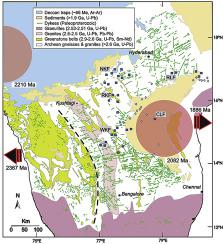Geoscience Frontiers ( IF 8.9 ) Pub Date : 2020-06-20 , DOI: 10.1016/j.gsf.2020.05.014 D. Srinivasa Sarma , V. Parashuramulu , M. Santosh , E. Nagaraju , N. Ramesh Babu

|
The Dharwar Craton in Peninsular India was intruded by a series of mafic dykes during the Paleoproterozoic and these mafic magmatic events have important implications on continental rifting and LIPs. Here we report ten precise Pb–Pb TE-TIMS age determinations on baddeleyite grains separated from seven mafic dykes and three sills, intruding into Archean basement rocks and Proterozoic sedimentary formations of the Eastern Dharwar Craton respectively. The crystallization age of the baddeleyite shows 2366.3 ± 1.1 Ma, and 2369.2 ± 0.8 Ma for the NE–SW trending dykes, 2368.1 ± 0.6 Ma, 2366.4 ± 0.8 Ma, 2207.2 ± 0.7 Ma and 1887.3 ± 1.0 Ma for the ENE–WNW to E–W striking dykes, 1880.6 ± 1.0 Ma, 1864.3 ± 0.6 Ma and 1863.6 ± 0.9 Ma for Cuddapah sills, and 1861.8 ± 1.4 Ma for the N–S trending dyke. Our results in conjunction with those from previous studies identify eight distinct stages of widespread Paleoproterozoic magmatism in the Dharwar craton. The mantle plume centres of the four radiating dyke swarms with ages of ~2367 Ma, ~2210 Ma, ~2082 Ma, and ~1886 Ma were traced to establish their proximity to the EDC kimberlite province. Though the ~2367 Ma and ~1886 Ma plume centres are inferred to be located to the west and east of the present day Dharwar craton respectively away from the kimberlite province, location of plume heads of the other two swarms with ages of ~2207 Ma and ~2082 Ma are in close proximity. In spite of the ubiquitous occurrence of dyke intrusions of all the seven generations in the kimberlite province, only few of these kimberlites are diamondiferous. Kimberlite occurrences elsewhere in the vicinity of older Large Igneous Provinces (LIPs) like the Mackenzie, Karoo, Parana-Etendeka and Yakutsk-Vilui are also non-diamondiferous. This has been attributed to the destruction of the lithospheric mantle keel (that hosts the diamonds) by the respective mantle plumes. The diamondiferous nature of the EDC kimberlites therefore suggests that plume activity does not always result in the destruction of the mantle keel.
中文翻译:

Dharwar Craton的铁磁性堤坝群的Pb–Pb Baddeleyite年龄:对古元古代LIP和地幔龙骨的金刚石潜力的暗示
印度半岛的达沃克拉通(Dharwar Craton)在古元古代期间被一系列铁镁质岩浆侵入,这些铁质岩浆事件对大陆裂谷和LIP具有重要意义。在这里,我们报告了十个精确的铅-铅TE-TIMS年龄测定,这些测定分别从七个铁镁质岩脉和三个基岩分离出来的杂辉岩晶粒上进行,分别侵入了东部达尔文克拉通的太古代基底岩和元古代沉积地层。斜方晶石的结晶年龄为2366.3±1.1 Ma,NE-SW趋势堤为2369.2±0.8 Ma,2368.1±0.6 Ma,2366.4±0.8 Ma,2207.2± ENE-WNW到E-W堤坝的0.7 Ma和1887.3±1.0 Ma,对于Cuddapah窗台,1880.6±1.0 Ma,1864.3±0.6 Ma和1863.6±0.9 Ma。 N–S趋势堤坝为1861.8±1.4 Ma。我们的结果与以前的研究结果相结合,确定了Dharwar克拉通中广泛的古元古代岩浆作用的八个不同阶段。追踪到四个辐射堤群的地幔柱中心,其年龄分别为〜2367 Ma,〜2210 Ma,〜2082 Ma和〜1886 Ma,以建立它们与EDC金伯利特省的距离。虽然推断〜2367 Ma和〜1886 Ma的羽状中心分别位于当今Dharwar克拉通的西部和东部,分别远离金伯利岩省,但其他两个群的羽状头的位置约为2207年Ma和〜2082 Ma非常接近。尽管在金伯利岩省的所有七代世代都出现了堤防入侵,但这些金伯利岩中只有极少数是含钻石的。金伯利岩发生在较早的大火成岩省(LIP)附近的其他地方,例如麦肯齐,卡鲁,巴拉那-埃滕德卡和雅库茨克-比吕伊。这归因于相应的地幔柱对岩石圈地幔龙骨(容纳钻石)的破坏。因此,EDC金伯利岩具有钻石般的性质,表明羽状活动并不总是导致地幔龙骨的破坏。


























 京公网安备 11010802027423号
京公网安备 11010802027423号